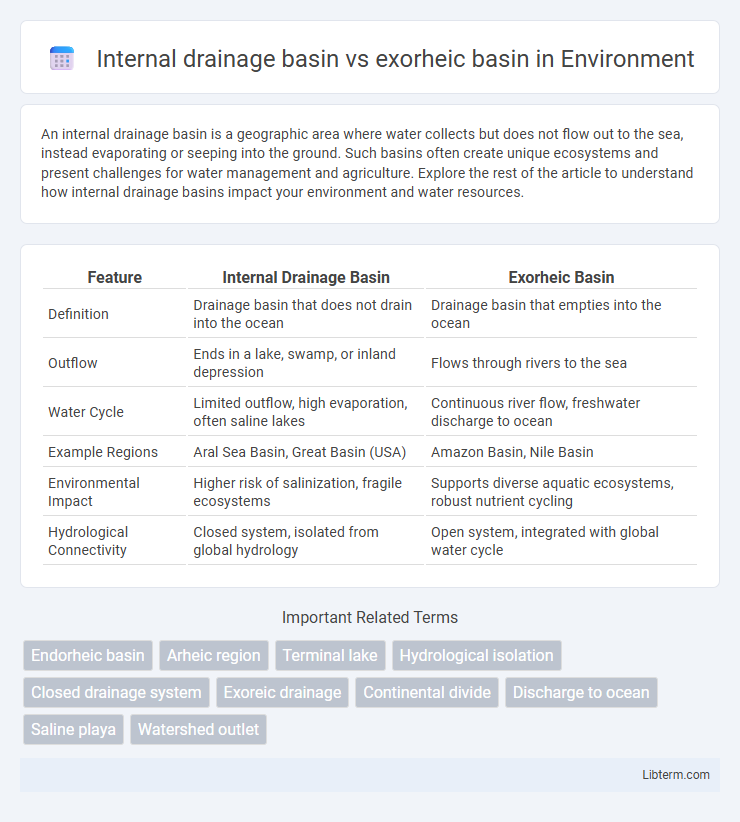An internal drainage basin is a geographic area where water collects but does not flow out to the sea, instead evaporating or seeping into the ground. Such basins often create unique ecosystems and present challenges for water management and agriculture. Explore the rest of the article to understand how internal drainage basins impact your environment and water resources.
Table of Comparison
| Feature | Internal Drainage Basin | Exorheic Basin |
|---|---|---|
| Definition | Drainage basin that does not drain into the ocean | Drainage basin that empties into the ocean |
| Outflow | Ends in a lake, swamp, or inland depression | Flows through rivers to the sea |
| Water Cycle | Limited outflow, high evaporation, often saline lakes | Continuous river flow, freshwater discharge to ocean |
| Example Regions | Aral Sea Basin, Great Basin (USA) | Amazon Basin, Nile Basin |
| Environmental Impact | Higher risk of salinization, fragile ecosystems | Supports diverse aquatic ecosystems, robust nutrient cycling |
| Hydrological Connectivity | Closed system, isolated from global hydrology | Open system, integrated with global water cycle |
Introduction to Drainage Basins
Internal drainage basins, also known as endorheic basins, are land areas where water does not flow out to external bodies like oceans but instead collects in lakes or evaporates. Exorheic basins discharge water through rivers or streams that eventually reach the sea, facilitating continuous water flow and sediment transport. Understanding the contrasting hydrological characteristics of internal versus exorheic drainage basins is essential for water resource management and ecosystem sustainability.
Defining Internal Drainage Basins
Internal drainage basins, also known as endorheic basins, are land areas where water does not flow out to the ocean but instead drains into local lakes or evaporates. These basins are characterized by closed hydrological systems, often found in arid or semi-arid regions, where water accumulates in salt flats or inland seas. Unlike exorheic basins, which channel water towards external outlets like rivers or oceans, internal drainage basins trap and retain water within their boundaries.
Understanding Exorheic Basins
Exorheic basins are drainage areas where rivers and streams discharge their water into the ocean or sea, supporting extensive aquatic ecosystems and facilitating sediment transport. These basins are characterized by external drainage networks that channel precipitation runoff beyond continental boundaries, promoting efficient water cycling and nutrient distribution. Unlike internal drainage basins, which retain water within closed loops forming endorheic lakes, exorheic basins maintain open hydrological systems crucial for sustaining regional biodiversity and human water resources.
Key Differences Between Internal and Exorheic Basins
Internal drainage basins, also known as endorheic basins, do not drain into an ocean or sea, causing water to accumulate in lakes or evaporate, whereas exorheic basins drain outward to the ocean or major water bodies. Internal basins often feature salt flats or saline lakes due to water evaporation, while exorheic basins support continuous river flow and sediment transport to the ocean. The hydrological cycle in internal basins is closed, leading to limited water exchange, compared to the open hydrological system of exorheic basins that facilitates global water circulation.
Geographic Distribution of Internal Basins
Internal drainage basins, also known as endorheic basins, predominantly occur in arid and semi-arid regions such as the Great Basin in the western United States, the Caspian Sea basin in Central Asia, and the Basin and Range Province. These basins are characterized by their lack of outlet to the sea, causing water to accumulate in salt lakes and playas. In contrast, exorheic basins have external drainage systems flowing to the ocean and are distributed more widely across humid and temperate climates, supporting river networks that discharge into seas or oceans.
Ecological Characteristics of Exorheic Basins
Exorheic basins exhibit dynamic ecological characteristics due to their continuous water flow, supporting diverse aquatic and riparian habitats with high species richness. These basins enable nutrient cycling and sediment transport, fostering productive ecosystems and connecting terrestrial and marine environments. The riverine connectivity in exorheic basins sustains key ecological processes such as fish migration and nutrient exchange, essential for maintaining regional biodiversity.
Hydrological Processes in Internal Drainage Basins
Internal drainage basins feature hydrological processes where water accumulates and evaporates within the basin without flowing to external water bodies, often resulting in the formation of salt flats or playas. Precipitation in these basins infiltrates the soil or evaporates due to limited surface runoff, creating unique groundwater recharge dynamics distinct from exorheic basins. The absence of outflow channels leads to the concentration of minerals and salts, influencing the hydrology and ecology of the basin.
Importance of Exorheic Basins for River Systems
Exorheic basins play a critical role in supporting extensive river systems by facilitating continuous water flow to the ocean, which sustains aquatic ecosystems and enables nutrient transport. These basins contribute to maintaining biodiversity, supporting agriculture, and replenishing groundwater through natural hydrological cycles. In contrast, internal drainage basins often lead to water stagnation and limited ecosystem connectivity due to their closed hydrological nature.
Human Impact on Internal and Exorheic Basins
Human activities profoundly affect internal drainage basins by intensifying water scarcity through over-extraction and pollution, disrupting natural hydrological cycles and reducing groundwater recharge. In exorheic basins, urbanization and industrial discharges alter river flow regimes and increase sediment loads, exacerbating flood risks and degrading aquatic ecosystems. Efficient water management and pollution control strategies are critical to mitigating these anthropogenic impacts on both internal and exorheic basin hydrology.
Conclusion: Comparing Internal and Exorheic Basins
Internal drainage basins are characterized by water that does not reach the ocean, often terminating in lakes or evaporating inland, whereas exorheic basins feature rivers that drain into the sea. The key distinction lies in their hydrological connectivity, where internal basins reflect endorheic conditions with closed drainage systems and exorheic basins exhibit open systems. These differences impact regional water balance, sediment transport, and ecosystem dynamics, making the classification critical for water resource management and environmental planning.
Internal drainage basin Infographic

 libterm.com
libterm.com